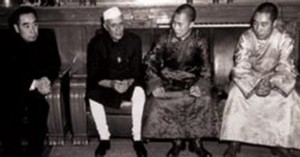The border between China and India has long been the subject of a territorial dispute between the two countries. Two of the main areas that are currently involved in the border conflict are the eastern state of Arunachal Pradesh, and Aksai Chin, the latter being a part of Ladakh, which is located in the northern Indian state of Jammu and Kashmir. The disputed claims to Aksai Chin and Arunachal Pradesh were one of the main causes of the Sino-Indian war which took place in 1962, as were the border conflicts involving the Tibetan Autonomous Region.
The 1914 Simla Accord—also known as the Convention Between Great Britain, China, and Tibet-recognised the independence of Tibet, but was not signed until 1938 due to differences arising from Chinese refusal in following the treaty. The Simla Accord most importantly established the border between Tibet and China and the border between Tibet and India through the McMahon Line. The line is the namesake of Sir Henry McMahon, who was a foreign secretary for British India and also one of the key diplomats involved in the Simla Accord. Following the 1959 Tibetan uprising, which was triggered by the ruthless oppression towards Tibetans by Chinese authorities during the Chinese invasion of Tibet, the McMahon line became a matter of contention-with China declaring the border to be invalid.

From Right: Panchen Lama and the Dalai Lama of Tibet with Nehru and a representative from China
Photo: bhuwanchand.wordpress.com
In 1954, the Panchsheel Agreement was signed by India and China as an attempt by Nehru to appease Chinese-Indian relations. This pact consisted of the following five key points: mutual respect for each other’s territorial integrity and sovereignty; mutual non-aggression; mutual non-interference in each other’s internal affairs; equality and cooperation for mutual benefit; and peaceful coexistence. At its core, the Panchsheel Agreement was a trading contract for India and China’s trade interests in Tibet. Of the Panchsheel Agreement, R N Ravi-a retired Special Director of the Intelligence Bureau-states, “The Panchsheel Agreement is India’s acquiescent endorsement of militarily altered, China-centric geopolitical and geostrategic balance of power on India’s northern frontiers. It willfully negated the shared cultural cosmology of India and Tibet organically nurtured over millennia. It voluntarily undid the centuries-old India-Tibet symbiotic relations that included free trans-border movements of pilgrims, scholars, artisans, tourists and traders, and undermined the historical treaties between India and Tibet and undercut the tenable bases of the traditionally settled borders.”
Following the election of Narendra Modi as the new Prime Minister of India, the relations between India and China will enter into a new dynamic. At a rally in Arunachal Pradesh in February Modi stated, “Arunachal Pradesh is an integral part of India and will always remain so.No power on earth can snatch away Arunachal Pradesh. Times have changed. The world does not welcome the mindset of expansion in today’s times. China will also have to leave behind its mindset of expansion.” Narendra Modi’s apparent stance concerning the Sino-Indian border dispute seems to be a stark contrast to that of India’s former prime ministers. Former Defense Minister of India and Samajwati Party leader Mulayam Singh Yadav stated, “First, BJP’s PM Atal Bihari Vajpayee succumbed and accepted that Tibet is part of China even when Tibet was our friendly nation and we had no threat from its borders. Manmohan Singh too accepted Vajpayee’s blunder and handed over Tibet to China. Our country had suffered due to the weak governments who could not defend national interest.”





 Print
Print Email
Email